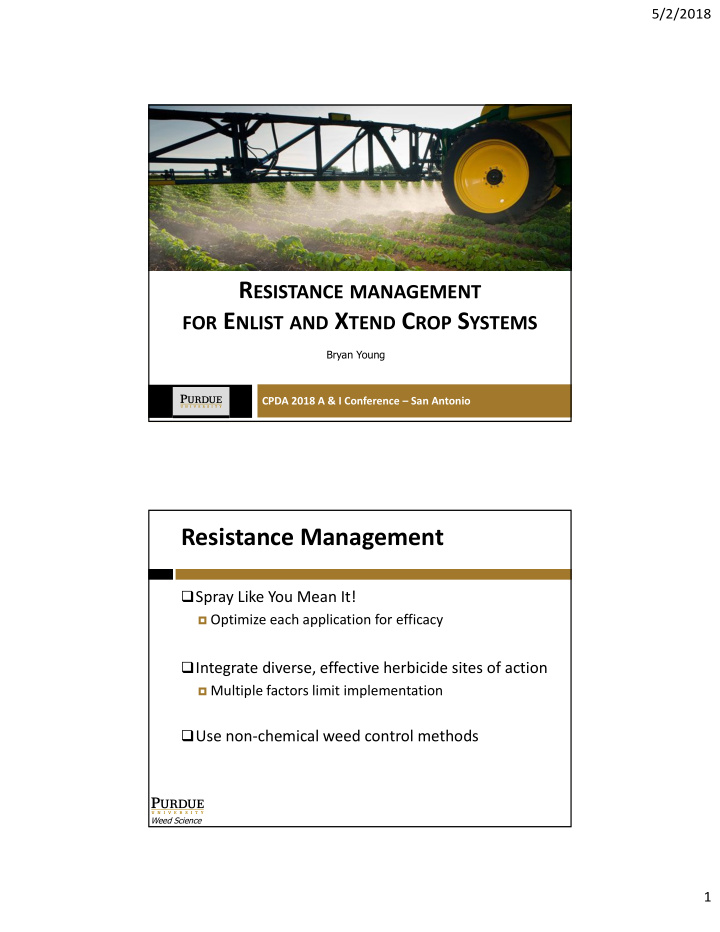



5/2/2018 R ESISTANCE MANAGEMENT FOR E NLIST AND X TEND C ROP S YSTEMS Bryan Young CPDA 2018 A & I Conference – San Antonio Resistance Management Spray Like You Mean It! Optimize each application for efficacy Integrate diverse, effective herbicide sites of action Multiple factors limit implementation Use non-chemical weed control methods Weed Science 1
5/2/2018 https://www.youtube.com/watch?v=9U5Z1MLMFAU http://cropwatch.unl.edu/2017/spraying-new-phenoxy-herbicide-formulations-xtend-and-enlist-soybeans Weed Science Drift Reduction Agents (DRAs) Polymer composition: Polyvinyl Polyacrylamide Hydroxypropyl guar ***Increase the viscosity of the spray solution*** Weed Science 2
5/2/2018 GPA for Dicamba in 2018 XTENDIMAX + ROUNDUP POWERMAX TTI11004 @ 40 PSI 10 GPA 15 GPA 20 GPA 12 MPH 8 MPH 6 MPH 3
5/2/2018 XMAX + PMAX + “water conditioner” + COC + INTACT TTI11004 @ 40 PSI 10 GPA 15 GPA 20 GPA 12 MPH 8 MPH 6 MPH XMAX + PMAX + SELECTMAX + WARRANT + INTACT TTI11004 @ 40 PSI 10 GPA 15 GPA 20 GPA 12 MPH 8 MPH 6 MPH 4
5/2/2018 Greater than 6” Good Luck! 4-6” 2” 3-4” Marginal Ideal Good Weed Science Spray Like You Mean It! Ultra Coarse droplets from nozzles w/wo DRAs are required for Xtend systems to manage physical spray drift. Can be used for effective weed management, but are prone to reduced weed control if spray coverage is compromised Will NEVER optimize herbicide efficacy Increasing the carrier volume to 15 or 20 GPA can regain spray coverage. Ultimately, the spray requirements for Xtend system are not ideal for herbicide activity which hastens the evolution of weed resistance to herbicides. Weed Science 5
5/2/2018 Herbicide-Resistant Weed Era Challenging, Fragile, Expensive Weed Science Mechanisms of Herbicide Resistance Target Site Altered binding site (DNA point mutation) Gene amplification for target site Non-Target Site Express different levels of weed Metabolism resistance to herbicides Compartmentalization Reduced translocation Increase in low-level resistance mechanisms Weed Science 6
5/2/2018 Weed Science Current/Future Soybean Traits MGI Soybean Weed Science 7
5/2/2018 Current/Future Soybean Traits MGI Soybean Weed Science Herbicide Program Evaluation Based on # of Herbicide Site of Action Groups Crop: Soybean (Dicamba; RR2Y Xtend) Target Weeds: Marestail (glyphosate-resistant) Waterhemp (ALS/PPO/glyphosate-resistant) Herbicide Program Group # # Effective on Waterhemp Glyphosate + 2,4-D - Burndown 9, 4 not applicable followed by Glyphosate + Xtendimax + 9, 4, 3 Fierce XLT - PRE 2, 14, 15 followed by Glyphosate + Engenia + Zidua - 9, 4, 15 2 POST Total for program 5 3 Weed Science 8
5/2/2018 Integrate Diverse, Effective Herbicide Sites of Action Cost, complexity, and marketing programs limits adoption of this strategy False sense by farmers that a single herbicide can ‘fix’ resistance Over-reliance on POST herbicides has allowed for the evolution of low-level resistance mechanisms Major need for soil residual herbicides!!! Weed Science Use Non-Chemical Weed Control Methods 9
5/2/2018 Resistance Management Spray Like You Mean It! Optimize each application for efficacy Integrate diverse, effective herbicide sites of action Multiple factors limit implementation Use non-chemical weed control methods Weed Science Resistance Management Spray Like You Mean It! Optimize each application for efficacy Integrate diverse, effective herbicide sites of action Multiple factors limit implementation Use non-chemical weed control methods Advantage when new traits allow for multiple effective POST herbicides? Weed Science 10
5/2/2018 Resistance Management Spray Like You Mean It! Optimize each application for efficacy Integrate diverse, effective herbicide sites of action Multiple factors limit implementation Use non-chemical weed control methods Advantage when new traits allow for multiple effective POST herbicides? Maybe Weed Science 11
Recommend
More recommend